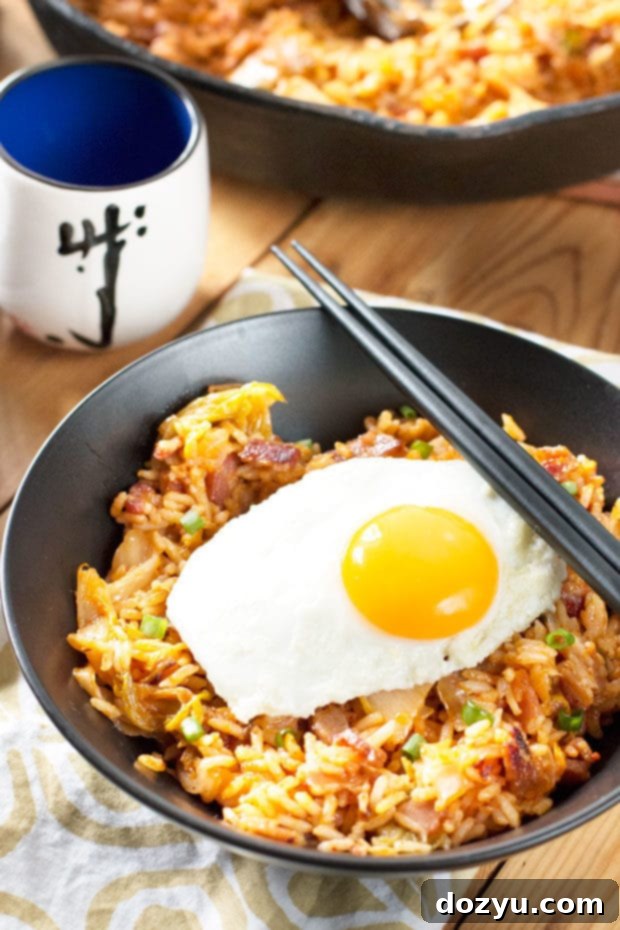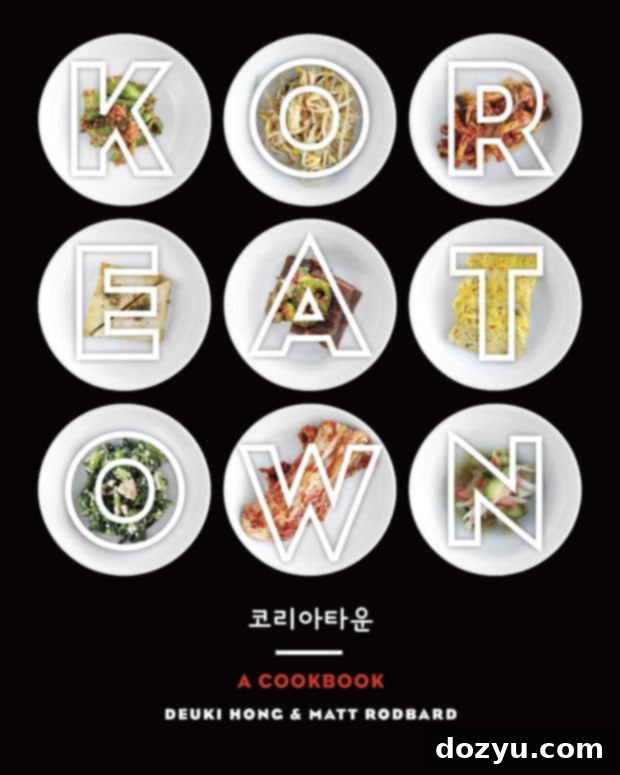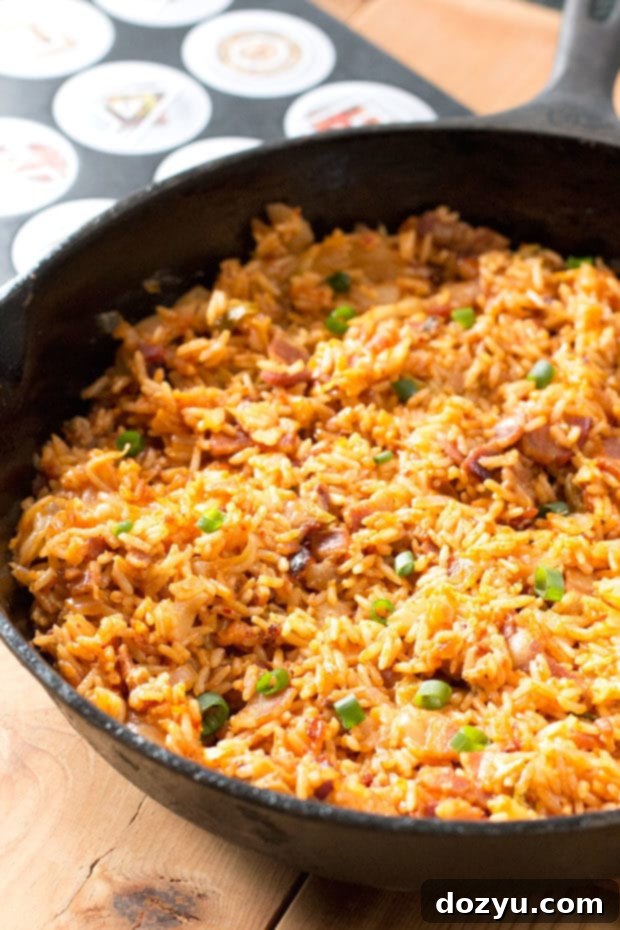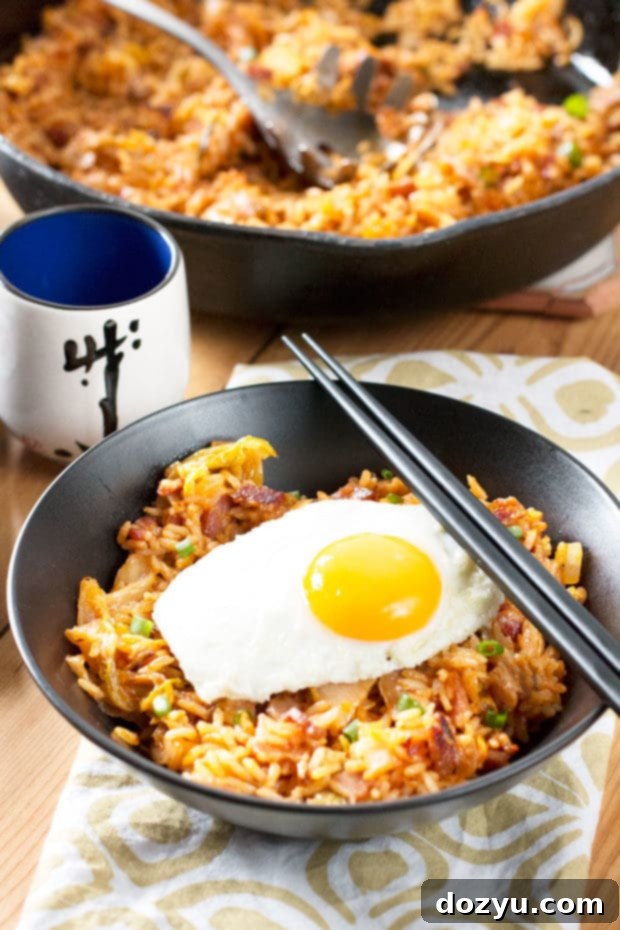The Ultimate Kimchi Fried Rice: A Journey into Authentic Korean Flavors with the Koreatown Cookbook
There are certain dishes that transcend the everyday meal, becoming not just sustenance, but an experience. For me, Kimchi Fried Rice, or as Deuki Hong and Matt Rodbard so aptly title it in their acclaimed Koreatown: A Cookbook, “Our Mildly Insane Kimchi Bokkeumbap,” is precisely that – an extraordinary weeknight meal. It’s a symphony of flavors, a masterclass in simplicity, and an incredibly quick culinary adventure that consistently ranks as one of my favorite dishes of the year. The addition of a perfectly fried egg on top elevates it from delicious to absolutely divine, making every bite a moment of pure bliss. This dish embodies the spirit of Korean comfort food, marrying bold, fermented notes with comforting textures.

Discovering the Depths of Korean Cuisine Through Koreatown: A Cookbook
My culinary explorations often push me beyond my familiar comfort zones, and in my quest for new and exciting flavors, Koreatown: A Cookbook became my next essential read and kitchen companion. What initially drew me to this vibrant collection of Korean recipes? Perhaps it was the lingering cultural fascination sparked by a previous obsession with K-pop sensation PSY, or my growing appreciation for soju, the iconic Korean distilled beverage. More likely, it was an undeniable curiosity, a desire to delve deeper into the intricate world of Korean staples like kimchi and gochujang, ingredients I had only scratched the surface of. From the very first pages, the book’s compelling narrative and mouth-watering recipes had me completely captivated, promising a true taste of Korea right in my own kitchen.
Authored by chef Deuki Hong and food writer Matt Rodbard, Koreatown isn’t just a recipe book; it’s a profound cultural immersion. It takes readers on a comprehensive journey through the heart of Korean-American culinary identity, exploring not only traditional dishes but also the vibrant, evolving food scene found in Korean enclaves across America. The book quickly became a phenomenon, celebrated for its authentic voice, its stunning photography, and its remarkable ability to demystify complex flavors for a global audience, making Korean cooking accessible to home cooks of all skill levels.

An Approachable Gateway to Authentic Korean Flavors
As someone who, despite a love for food shows like Top Chef, felt quite uninitiated when it came to truly understanding and executing Korean flavors, this cookbook proved to be incredibly approachable. It brilliantly bridges the gap between traditional Korean cooking techniques and the practicalities of the home kitchen, making what might seem intimidating delightfully accessible. The recipes are meticulously broken down with clear instructions, ensuring that even a novice cook can confidently navigate the steps. Beyond the recipes themselves, a comprehensive introductory section serves as an invaluable primer, guiding readers through the fascinating world of unique, often funky and fermented ingredients – essential components of Korean cuisine that might be unfamiliar, especially if your culinary background, like mine, was rooted in a more “white bread suburbia” experience. This deep dive into ingredients like gochujang, doenjang, various types of kimchi, and Korean soy sauce not only educates but also empowers cooks to truly understand the building blocks of authentic Korean taste.
My journey into Korean BBQ began relatively recently at a fantastic restaurant here in Denver. It was there that I discovered the magic of authentic kimchi – a flavor profile so captivating that it quickly became something I genuinely *crave*. The rich, spicy, tangy, and deeply savory notes of perfectly fermented kimchi are simply irresistible, boasting incredible depth and a delightful crunch. So, when my eyes laid upon the kimchi fried rice recipe within the pages of Koreatown, I knew, without a shadow of a doubt, that this had to be the very first dish I attempted. It was a clear call to my newfound obsession, a promise of an explosion of flavor that I couldn’t ignore, offering a perfect entry point into Korean home cooking.

The Irresistible Allure and Flavor Profile of Kimchi Fried Rice
The beauty of this particular kimchi fried rice recipe lies not only in its sensational flavor but also in its remarkable simplicity and speed. It comes together in less than 30 minutes, making it a perfect solution for busy weeknights when you crave something extraordinary without spending hours in the kitchen. But let’s talk about the flavor – oh, the flavor! It’s a culinary revelation that truly explodes in your mouth. In my nearly three decades of life, few dishes have offered such a profound and layered taste experience. There’s an incredible depth that comes from the fermented kimchi and rich bacon fat, a vibrant brightness from fresh aromatics, a satisfying savoriness, and that elusive yet unmistakable umami that permeates every single grain of rice. Each bite is a complex interplay of textures and tastes, leaving you utterly consumed and already yearning for the next spoonful before you’ve even fully savored the one in your mouth. It’s truly a testament to the power of well-balanced Korean flavors, creating a harmony that is both exciting and deeply satisfying.
What makes Kimchi Fried Rice such a globally beloved dish? It’s the perfect fusion of humble ingredients transformed into something extraordinary. The combination of spicy, sour kimchi with savory meat (often bacon or pork belly), aromatic vegetables like onions, garlic, and ginger, and perfectly cooked rice creates a dish that is both comforting and exhilarating. The adaptability of the dish also contributes to its popularity, allowing for variations with different proteins or vegetables, yet always retaining its core, irresistible character. It’s a dish that tells a story of Korean culinary ingenuity – making the most of staples to create something universally appealing, packed with probiotics and incredible zest.

The Secrets to Unforgettable Kimchi Fried Rice: Bacon and Day-Old Rice
The Koreatown cookbook emphasizes a crucial aspect of their Kimchi Fried Rice: bacon, and a generous amount of it. The authors highlight that bacon, a quintessential American comfort food, was essential to their vision for this fusion dish. They tested the recipe repeatedly, initially finding the bacon’s essence overshadowed by other bold ingredients. Their brilliant solution? More bacon! They draw a fascinating analogy to French chefs’ approach to mashed potatoes – using equal parts butter and potatoes for ultimate decadence. This might sound intimidating, even “scary” to some, but as they put it, it’s “also scary good.” This generous inclusion of bacon creates a foundational richness and a depth of flavor that is truly unparalleled, making the dish undeniably crave-worthy.
The rendered bacon fat forms the perfect base, melding with the aromatic onions, garlic, and ginger before the star of the show – the tangy, spicy kimchi – is introduced. The crispy bits of bacon add a delightful textural contrast, enhancing the overall experience with every bite. Furthermore, the recipe introduces an ingenious “gochujang butter,” a simple yet transformative addition that melts into the hot rice at the very end, infusing it with a creamy, spicy, and deeply savory finish. Gochujang itself is a fermented Korean chili paste, known for its complex sweet, spicy, and savory profile, and its incorporation here is nothing short of brilliant, adding another layer of umami that elevates the entire dish.
Another critical element for achieving the perfect kimchi fried rice texture is the use of cold, day-old rice. Freshly cooked rice is too moist, leading to a gummy rather than crispy fried rice. Day-old rice, having dried out in the refrigerator, fries beautifully, developing those coveted crispy edges reminiscent of Spanish paella. The goal is to get that satisfying “crust” on the bottom layer of rice. The cookbook even offers a clever hack: if you haven’t planned ahead, simply spread freshly cooked rice thinly on a sheet tray and freeze it until thoroughly cold. This ensures that crispy texture, a hallmark of excellent fried rice, is always within reach, making this a dish you can whip up even on a whim.

The Heavenly Topping: A Perfectly Fried Egg
To truly complete this magnificent dish, a sunny-side up egg is not just an optional extra; it’s a non-negotiable component that brings everything together. Douse the entire fiery, flavorful rice concoction in a perfectly cooked egg, with its runny yolk ready to break and coat everything in its creamy goodness, and you’ll understand the “WOW” factor. The rich, velvety yolk acts as a luxurious sauce, tempering the spice of the gochujang and kimchi while adding an unparalleled richness that ties all the complex flavors together. This harmonious blend of spicy, savory, and creamy elements creates a truly heartwarming, soul-satisfying comfort food experience I only wish I had grown up with. (Sorry, Mom, your cooking was great, but this is truly next level!)
Beyond the Recipe: Your Comprehensive Guide to the Korean Pantry
If you’re contemplating a deeper dive into Korean cuisine, this cookbook, and particularly this kimchi fried rice recipe, is the absolute best starting point. It’s not just about following instructions; it’s about understanding the heart and soul of Korean cooking. Beyond the delicious dishes, Koreatown serves as an invaluable guide to navigating the potentially overwhelming aisles of your local Asian market. It sheds light on countless ingredients that you might otherwise overlook, providing essential context, usage tips, and helping you build a truly authentic Korean pantry. Learning about these ingredients opens up a world of possibilities for future culinary adventures, allowing you to confidently experiment and create your own Korean-inspired masterpieces.
This cookbook, with its engaging prose, vibrant photography, and genuinely delicious and approachable recipes, empowers home cooks to confidently recreate restaurant-quality Korean food in their own kitchens. It encourages experimentation, fosters a deeper appreciation for a cuisine rich in history and bold flavors, and transforms daunting foreign ingredients into familiar friends. From understanding the nuances of different fermented pastes to mastering the art of a perfectly crisp fried rice, Koreatown ensures a rewarding and delicious cooking journey.
Seriously, just try this Kimchi Fried Rice recipe. Trust me, you will be absolutely SOLD on the magic of this iconic Korean dish and the culinary brilliance of the Koreatown cookbook. It’s a meal that promises to become a regular fixture in your weeknight rotation.
Disclosure: I received a copy of this book from the publisher/Blogging for Books in exchange for my honest review.

Kimchi Fried Rice
We went that direction here and by the grace of god and Allan Benton did this ever work. The crispy rice unites with the decadent gochujang butter, while the bacon is there just being wonderful. And remember, the key to good fried rice is using cold day-old rice, which is nice and dried out and gives you a much better fry. So the next time you order takeout, get an extra order of rice and keep it in the fridge for a day or so. And if you didn’t plan ahead, no sweat. Make some rice and lay it out on a sheet tray and freeze until cold.
ingredients
- 1/2 lb of slab bacon roughly chopped
- 1 medium onion cut into small dice
- 2 garlic cloves minced
- 1- inch knob of ginger minced
- 1 1/2 cups chopped extra-aged Nappa Cabbage Kimchi recipe in cookbook or store-bought works here too!
- 2 cups cooked rice preferably day-old
- 1 Tbsp gochujang
- 2 Tbsp butter softened
- 2 eggs fried sunny-side up
- 2 scallions sliced thin
instructions
-
In a large skillet, wok or cast-iron pan over high heat, cook the bacon, stirring, until fat is fully rendered and the bacon is barely starting to crisp. Pour out all but 2 tablespoons fat.
-
Add onion, garlic and ginger and sauté for 1 minute, or until very aromatic. Add chopped kimchi and rice and sauté, stirring frequently, for 4 to 5 minutes, or until very hot. Drop the heat to medium-low and flatten the rice with your spatula. Continue to cook until the bottom layer is crispy, about 2 minutes; think Spanish paella here. The longer you leave it, the more crispy the bottom will become, but be careful not to burn the garlic.
-
While the rice continues to crisp, in a small bowl mix together the gochujang and softened butter.
-
Serve from the pan or wok, topped with fried eggs, sliced scallions and gochujang butter.
